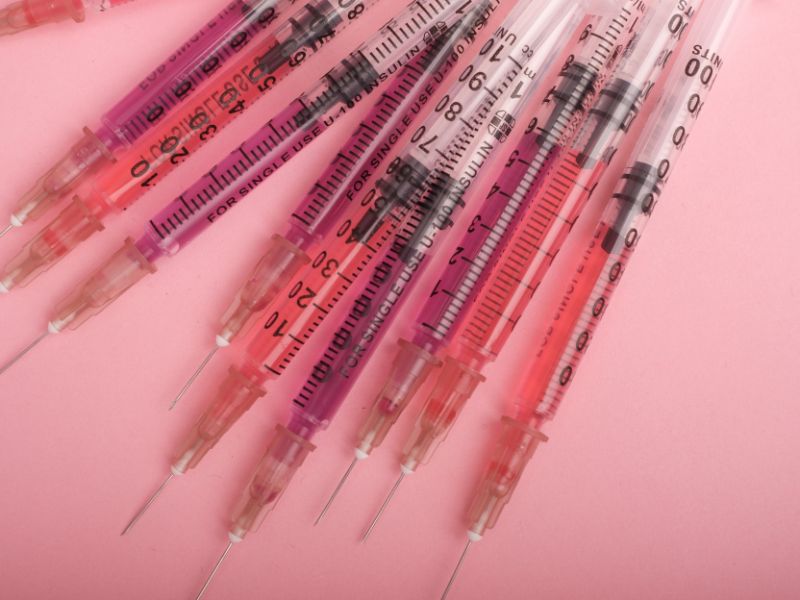Xenoestrogens: An Introduction
Most of us don’t think twice about what’s in our cosmetics, the plastic containers we use, or even the foods we consume daily. Yet, these everyday items could be sources of something called xenoestrogens – a term that might sound like it belongs in a science fiction novel, but is very much a part of our real world. Xenoestrogens are synthetic chemicals that mimic the behavior of estrogens, the hormones critical to our reproductive and overall health.
These chemical imposters are found in a surprising array of products, from the plastic bottle holding your water to the lotion you apply on your skin. While the concept might initially seem abstract or distant, the reality is that these substances are silently integrating into our daily lives, potentially influencing our health in ways we’re only beginning to understand.
In this article, we’ll dive into what xenoestrogens are, where they lurk, and why there’s growing concern among health professionals about their impact. Whether you’re a health enthusiast, a concerned parent, or simply someone curious about the unseen influences on your health, understanding xenoestrogens is a step towards making more informed choices for your well-being
Sources of Xenoestrogens
When we hear the word ‘contaminants’, we might think of industrial smokestacks or polluted rivers. However, some of these contaminants are closer to home than we might realize. Xenoestrogens, despite their complicated name, are found in many everyday items. Let’s uncover some of the most common sources:
- Plastics and Food Packaging: One of the most ubiquitous sources of xenoestrogens is plastic. Chemicals like Bisphenol A (BPA), commonly found in plastic bottles and food containers, can leach into our food and drinks, especially when heated.
- Cosmetics and Personal Care Products: From shampoos to lotions, many beauty and personal care products contain parabens and phthalates, which are known xenoestrogens. These products are in direct contact with our skin, potentially allowing these chemicals to be absorbed into our bodies.
- Household Products: Surprisingly, everyday items like cleaning agents, plastic toys, and even some types of non-stick cookware can be sources of xenoestrogens.
- Industrial Chemicals and Pesticides: Residues from pesticides used in agriculture and certain chemicals used in industrial processes can also contain xenoestrogens. These can find their way into our food chain and water supply.
- Food: Yep, even some foods naturally contain phytoestrogens, plant-derived compounds similar to estrogen. However, the concern is more about meat and dairy products from animals exposed to hormone treatments, which can contain synthetic estrogens.
Understanding these sources is the first step in recognizing how widespread xenoestrogens are in our environment. It’s not just about what we apply on our skin or the containers we use for our food; it’s also about the broader environment we live in. As we continue to explore the impact of these chemicals, the knowledge of where they are found can help us make more informed choices.
Biological Effects of Xenoestrogens
Now that we know where xenoestrogens are found, you might be wondering, “What do they actually do in our bodies?” The answer lies in their ability to mimic estrogen, a natural hormone crucial for various bodily functions. Here’s how these chemical imposters can impact our health:
- Hormonal Disruption: Xenoestrogens can bind to estrogen receptors in our cells, mimicking the effects of natural estrogen. This imitation can disrupt the delicate balance of our endocrine system, which is responsible for regulating hormones in our body.
- Reproductive Health Concerns: For women, excessive exposure to xenoestrogens may lead to issues like menstrual irregularities, reduced fertility, and increased risk of certain cancers like breast cancer. In men, these chemicals have been linked to lowered sperm count and quality, and an increased risk of testicular cancer.
- Developmental Effects: Pregnant women and children are particularly sensitive to hormonal disruptions. Exposure to xenoestrogens during pregnancy can potentially affect the development of the fetus, leading to health issues later in life. In children, these chemicals may influence early puberty and developmental growth.
- Other Health Implications: The effects of xenoestrogens aren’t limited to reproductive health. They have been associated with weight gain, diabetes, and even neurodevelopmental issues.
In the next section, we’ll look at the contrasting views in the scientific community about the impact of xenoestrogens.
Xenoestrogens, Detoxification, and Genetic Variations (SNPs)
As we’ve seen, xenoestrogens are synthetic chemicals that can disrupt our hormonal balance. But how our bodies deal with these chemicals can vary significantly from person to person. This variability is often influenced by our body’s detoxification processes and our unique genetic makeup, particularly the Single Nucleotide Polymorphisms (SNPs).
Detoxification Process: Our bodies have natural mechanisms to detoxify and eliminate harmful substances, including xenoestrogens. This process mainly occurs in the liver and involves various phases. Each phase is designed to make these chemicals less harmful and easier to eliminate from the body.
Role of SNPs in Detoxification: SNPs are variations in a single nucleotide (building block of DNA) in our genetic code. These variations can affect how genes function. In the context of detoxification, certain SNPs can influence how effectively our body processes and eliminates xenoestrogens. For example, a SNP in a gene encoding for a detoxification enzyme might result in reduced enzyme activity, leading to slower or less efficient processing of these chemicals.
Impact on Health: If the detoxification process is less efficient due to certain SNPs, xenoestrogens may accumulate in the body, potentially increasing the risk of the adverse health effects previously discussed. This accumulation can be particularly concerning because xenoestrogens are fat-soluble, meaning they can be stored in body fat and released over time.
Individual Variability: This genetic variability explains why some people might be more sensitive to the effects of xenoestrogens than others. It’s a crucial aspect of personalized medicine and functional medicine approaches, which often consider individual genetic differences when addressing health concerns.
Understanding the interaction between xenoestrogens, our body’s detoxification pathways, and genetic factors like SNPs helps us appreciate the complexity of how these chemicals can impact our health. It underscores the importance of personalized approaches in healthcare, taking into account the unique genetic makeup of each individual.
The Role of CYP1B1 in Metabolizing Xenoestrogens
Among the various genes and enzymes involved in our body’s detoxification processes, CYP1B1 holds a significant place, especially in the context of xenoestrogens. Understanding its role provides insight into how our bodies handle these foreign chemicals. (1)
What is CYP1B1?
- CYP1B1 is part of the cytochrome P450 family of enzymes, which play a key role in metabolizing various substances, including drugs, toxins, and hormonal substances.
- This enzyme is particularly important for the metabolism of estrogens and similar compounds, like xenoestrogens.
CYP1B1 and Xenoestrogens:
- CYP1B1 helps convert xenoestrogens into forms that can be more easily eliminated from the body.
- The efficiency of this process can vary depending on genetic variations (SNPs) in the CYP1B1 gene. These variations can affect how well the enzyme functions and, consequently, how effectively xenoestrogens are metabolized.
Health Implications:
- Inefficient metabolism of xenoestrogens, due to less active variants of CYP1B1, may lead to their accumulation in the body. This accumulation can potentially exacerbate the disruptive effects of xenoestrogens on the endocrine system.
- Research suggests that variations in CYP1B1 may also be linked to an increased risk of certain hormone-related cancers, highlighting the importance of this enzyme in overall hormonal regulation and cancer prevention.
Testing and Personalized Approaches:
- Genetic testing can identify SNPs in the CYP1B1 gene, providing insight into an individual’s ability to process xenoestrogens.
- With this information, personalized strategies can be developed to support the body’s detoxification processes. This might include dietary adjustments, lifestyle changes, or targeted supplementation.
The CYP1B1 enzyme plays a crucial role in how our bodies deal with xenoestrogens. Variations in this gene can significantly impact our susceptibility to the harmful effects of these chemicals. Understanding and addressing these individual differences is an important step in managing our health in an environment increasingly laden with synthetic substances.
Testing for Xenoestrogen Exposure and Genetic Susceptibility
Understanding our individual exposure to xenoestrogens and how our bodies process these chemicals is key to managing their potential health impacts. So, how do we test for these factors? This section explores the available testing methods.
Testing for Xenoestrogen Exposure:
- Blood and Urine Tests: These are the most common methods for detecting the presence of xenoestrogens in the body. They can measure levels of specific chemicals known to act as xenoestrogens.
- Adipose Tissue Sampling: Since xenoestrogens are fat-soluble, analyzing adipose (fat) tissue can provide insights into long-term exposure.
Genetic Testing for SNPs:
- DNA Tests: These tests can identify specific SNPs associated with detoxification processes. By analyzing a person’s genetic code, usually obtained through a saliva or blood sample, these tests can determine if an individual has variations that might affect their ability to process and eliminate xenoestrogens efficiently.
- Functional Lab Testing: Beyond just identifying SNPs, some tests can assess how well certain detoxification pathways are functioning in the body. This can be done through specific biochemical tests that measure the activity of enzymes involved in detoxification.
Interpreting Test Results:
It’s important to note that the presence of xenoestrogens in the body or having certain SNPs doesn’t automatically translate to health issues. The interpretation of these tests should be done by healthcare professionals who can consider the overall health, lifestyle, and environmental factors.
A holistic approach is often necessary. For instance, high levels of xenoestrogens might be concerning, but factors like diet, stress, and overall health also play significant roles in how these chemicals affect us.
Limitations and Considerations:
These tests can be valuable tools, but they have limitations. For example, not all xenoestrogens can be easily detected, and genetic testing can’t predict all aspects of detoxification efficiency.
Environmental and lifestyle factors, like diet and exposure to other chemicals, also significantly impact how xenoestrogens affect our health.
In summary, testing for xenoestrogen exposure and genetic susceptibility provides valuable insights but should be part of a broader health assessment. Understanding these results can help individuals and healthcare providers develop more personalized strategies for managing exposure and supporting the body’s natural detoxification processes.
Strategies for Reducing Xenoestrogen Exposure and Supporting Detoxification
Knowing about xenoestrogens and how our bodies handle them naturally leads to the question: What can we do to reduce our exposure and support our body’s detoxification processes? Here are some practical strategies:
Minimizing Exposure to Xenoestrogens:
- Choose Safer Products: Opt for BPA-free plastics, and use glass when possible, especially for food and drink storage.
- Select Natural Personal Care Products: Look for cosmetics and toiletries that are free from parabens, phthalates, and other known xenoestrogens.
- Be Mindful of Food Sources: Choose organic produce to avoid pesticide residues, and consider the sources of meat and dairy to reduce exposure to hormonally treated products.
Supporting Detoxification:
- Diet: Incorporate foods that support liver health and detoxification, like cruciferous vegetables, berries, and foods rich in antioxidants.
- Hydration: Drinking enough water is essential for helping the body eliminate toxins.
- Exercise: Regular physical activity can boost circulation and help in toxin elimination through sweat.
- Sauna Sessions: Speaking of sweat…regular sauna sessions is one of the best ways to enhance detoxification. Click here for our favorite portable sauna!
Considering Genetic Factors:
- If genetic testing reveals SNPs that affect detoxification, specific interventions can be tailored. For example, certain dietary supplements or foods might be recommended to support particular detoxification pathways. (See supplement recommendations below!)
- Consulting with a healthcare professional who understands genetic testing can provide personalized advice based on your unique genetic makeup.
Lifestyle Changes:
- Stress Reduction: Chronic stress can impact the body’s ability to detoxify effectively. Practices like meditation, yoga, or regular exercise can help manage stress.
- Avoid Smoking and Limit Alcohol: These habits can put additional strain on your body’s detoxification systems.
My Favorite Detox Supplements
To support the body’s natural detoxification processes in dealing with xenoestrogens, certain supplements can be considered. However, it’s important to consult with a healthcare professional before starting any supplement regimen, especially if you have any health conditions or are taking medications. Here are some commonly suggested supplements:
Milk Thistle: Known for its liver-supporting properties, which can aid in detoxification.
Calcium-D-Glucarate: May help in detoxifying and eliminating estrogen and other toxins.
Diindolylmethane (DIM): Found in cruciferous vegetables, it may promote healthier estrogen metabolism.
Probiotics: Support gut health, which is crucial for detoxification and overall health.
Fiber Supplements: Aid in digestion and elimination, helping to remove toxins from the body.
Green Tea Extract: Contains antioxidants that may support detoxification processes.
Curcumin (Turmeric): Has anti-inflammatory properties and may support liver health.
N-Acetyl Cysteine (NAC): Supports the production of glutathione, a key antioxidant in detoxification.
Below are a few of my favorite supplements that I use in addition to the above.

HistaQuel
Histaquel, which often contains quercetin, is primarily marketed for its potential anti-histamine and anti-inflammatory properties, particularly in relation to allergies and immune system reactions.
Quercetin is known for its antioxidant properties and has been studied for various health benefits, including its potential protective effects against xenoestrogens

Prime Time
Prime Time by Healthgevity includes Apigenin, a natural flavonoid found in many plants, is known for its potential health benefits, including anti-inflammatory and antioxidant effects.
Apigenin may play a role in modulating the body’s response to these external estrogen mimickers.
In Conclusion:
While it’s nearly impossible to eliminate all exposure to xenoestrogens, being aware of their sources and taking steps to reduce contact can significantly decrease their impact on our health. Combining these efforts with strategies to support the body’s natural detoxification processes, especially in light of individual genetic factors, can help mitigate the risks associated with these chemicals.
Feel free to leave any and all of your questions below, or book a consult with me and my team today!
❤️

Wendy Finkelstein, PA-C
Wendy Finkelstein is a board-certified Physician Assistant who believes that aging is a call for celebration and an opportunity to feel grateful for your body and its incredible ability to transform. Wendy believes that deconstructing the common paradigms of the aging process can fully help us to embrace our youth at any age. With a focus on mitochondrial repair, Wendy approaches Functional Medicine from the cellular level.









